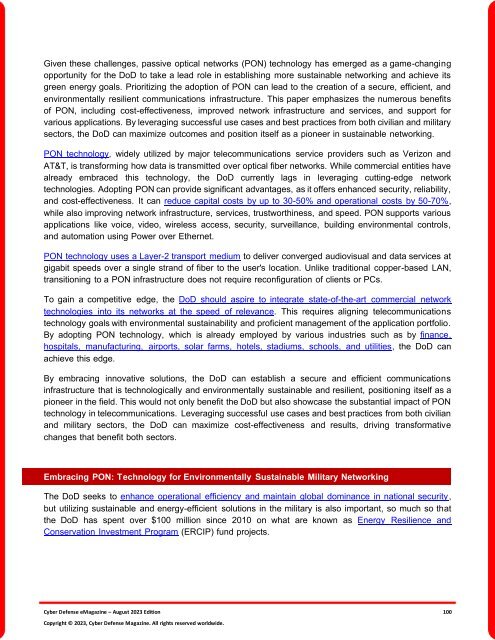The Cyber Defense eMagazine August Edition for 2023
Cyber Defense eMagazine August Edition for 2023 #CDM #CYBERDEFENSEMAG @CyberDefenseMag by @Miliefsky a world-renowned cyber security expert and the Publisher of Cyber Defense Magazine as part of the Cyber Defense Media Group as well as Yan Ross, Editor-in-Chief and many more writers, partners and supporters who make this an awesome publication! Thank you all and to our readers! OSINT ROCKS! #CDM #CDMG #OSINT #CYBERSECURITY #INFOSEC #BEST #PRACTICES #TIPS #TECHNIQUES
Cyber Defense eMagazine August Edition for 2023 #CDM #CYBERDEFENSEMAG @CyberDefenseMag by @Miliefsky a world-renowned cyber security expert and the Publisher of Cyber Defense Magazine as part of the Cyber Defense Media Group as well as Yan Ross, Editor-in-Chief and many more writers, partners and supporters who make this an awesome publication! Thank you all and to our readers! OSINT ROCKS! #CDM #CDMG #OSINT #CYBERSECURITY #INFOSEC #BEST #PRACTICES #TIPS #TECHNIQUES
Create successful ePaper yourself
Turn your PDF publications into a flip-book with our unique Google optimized e-Paper software.
Given these challenges, passive optical networks (PON) technology has emerged as a game-changing<br />
opportunity <strong>for</strong> the DoD to take a lead role in establishing more sustainable networking and achieve its<br />
green energy goals. Prioritizing the adoption of PON can lead to the creation of a secure, efficient, and<br />
environmentally resilient communications infrastructure. This paper emphasizes the numerous benefits<br />
of PON, including cost-effectiveness, improved network infrastructure and services, and support <strong>for</strong><br />
various applications. By leveraging successful use cases and best practices from both civilian and military<br />
sectors, the DoD can maximize outcomes and position itself as a pioneer in sustainable networking.<br />
PON technology, widely utilized by major telecommunications service providers such as Verizon and<br />
AT&T, is trans<strong>for</strong>ming how data is transmitted over optical fiber networks. While commercial entities have<br />
already embraced this technology, the DoD currently lags in leveraging cutting-edge network<br />
technologies. Adopting PON can provide significant advantages, as it offers enhanced security, reliability,<br />
and cost-effectiveness. It can reduce capital costs by up to 30-50% and operational costs by 50-70%,<br />
while also improving network infrastructure, services, trustworthiness, and speed. PON supports various<br />
applications like voice, video, wireless access, security, surveillance, building environmental controls,<br />
and automation using Power over Ethernet.<br />
PON technology uses a Layer-2 transport medium to deliver converged audiovisual and data services at<br />
gigabit speeds over a single strand of fiber to the user's location. Unlike traditional copper-based LAN,<br />
transitioning to a PON infrastructure does not require reconfiguration of clients or PCs.<br />
To gain a competitive edge, the DoD should aspire to integrate state-of-the-art commercial network<br />
technologies into its networks at the speed of relevance. This requires aligning telecommunications<br />
technology goals with environmental sustainability and proficient management of the application portfolio.<br />
By adopting PON technology, which is already employed by various industries such as by finance,<br />
hospitals, manufacturing, airports, solar farms, hotels, stadiums, schools, and utilities, the DoD can<br />
achieve this edge.<br />
By embracing innovative solutions, the DoD can establish a secure and efficient communications<br />
infrastructure that is technologically and environmentally sustainable and resilient, positioning itself as a<br />
pioneer in the field. This would not only benefit the DoD but also showcase the substantial impact of PON<br />
technology in telecommunications. Leveraging successful use cases and best practices from both civilian<br />
and military sectors, the DoD can maximize cost-effectiveness and results, driving trans<strong>for</strong>mative<br />
changes that benefit both sectors.<br />
Embracing PON: Technology <strong>for</strong> Environmentally Sustainable Military Networking<br />
<strong>The</strong> DoD seeks to enhance operational efficiency and maintain global dominance in national security,<br />
but utilizing sustainable and energy-efficient solutions in the military is also important, so much so that<br />
the DoD has spent over $100 million since 2010 on what are known as Energy Resilience and<br />
Conservation Investment Program (ERCIP) fund projects.<br />
<strong>Cyber</strong> <strong>Defense</strong> <strong>eMagazine</strong> – <strong>August</strong> <strong>2023</strong> <strong>Edition</strong> 100<br />
Copyright © <strong>2023</strong>, <strong>Cyber</strong> <strong>Defense</strong> Magazine. All rights reserved worldwide.

















